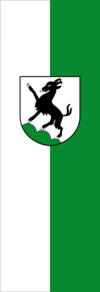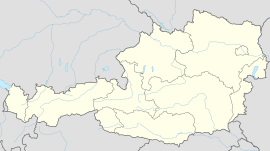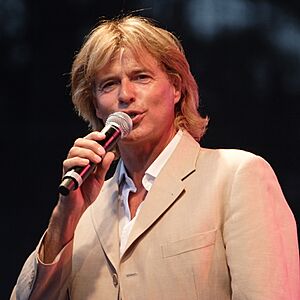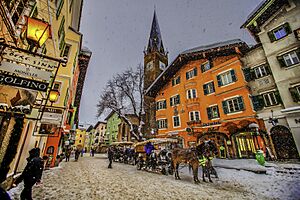Kitzbühel facts for kids
Quick facts for kids
Kitzbühel
|
|||
|---|---|---|---|
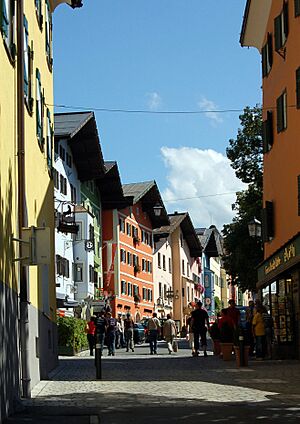
Kitzbühel in mid-August 2008
|
|||
|
|||
| Country | Austria | ||
| State | Tyrol | ||
| District | Kitzbühel | ||
| Area | |||
| • Total | 58.01 km2 (22.40 sq mi) | ||
| Elevation | 762 m (2,500 ft) | ||
| Time zone | UTC+1 (CET) | ||
| • Summer (DST) | UTC+2 (CEST) | ||
| Postal code |
6370
|
||
| Area code | 05356 | ||
| Vehicle registration | KB | ||
| Website | Kitzbühel | ||
Kitzbühel is a historic town in Tyrol, Austria. It is located in the Kitzbühel Alps along the Kitzbüheler Ache river. The town is about 100 kilometers (62 miles) east of Innsbruck, the state capital. Kitzbühel is also the main town of the Kitzbühel district.
This town is famous around the world as a top ski resort. Many international visitors come here for vacations. It is also known for having some of the most expensive real estate in Austria. Its closeness to Munich makes it a popular spot for vacation homes for people from Germany.
Contents
Geography of Kitzbühel
Kitzbühel is nestled in the Kitzbühel Alps. It sits between the towns of Zell am See and Innsbruck. The town is located in the Leukental valley, right on the Kitzbüheler Ache river.
The town is divided into several smaller areas. These include Am Horn, Bichlach, Kaps, and Gundhabing. Other areas are Mühlau, Schattberg, and Staudach.
Kitzbühel shares its borders with several nearby towns. These are Aurach bei Kitzbühel, Jochberg, and Kirchberg in Tirol. It also borders Oberndorf in Tirol, Reith bei Kitzbühel, St. Johann in Tirol, and Fieberbrunn.
The old part of Kitzbühel is mostly free of cars. Here, you can find many fancy shops, cafes, and great restaurants.
Kitzbühel's Climate
| Weather chart for Kitzbühel | |||||||||||||||||||||||||||||||||||||||||||||||
|---|---|---|---|---|---|---|---|---|---|---|---|---|---|---|---|---|---|---|---|---|---|---|---|---|---|---|---|---|---|---|---|---|---|---|---|---|---|---|---|---|---|---|---|---|---|---|---|
| J | F | M | A | M | J | J | A | S | O | N | D | ||||||||||||||||||||||||||||||||||||
|
71
1
-8
|
67
4
-6
|
85
9
-3
|
82
13
1
|
109
19
6
|
157
21
9
|
172
23
11
|
151
23
11
|
103
19
8
|
74
14
3
|
82
6
-2
|
83
2
-6
|
||||||||||||||||||||||||||||||||||||
| temperatures in °C precipitation totals in mm source: ZAMG |
|||||||||||||||||||||||||||||||||||||||||||||||
|
Imperial conversion
|
|||||||||||||||||||||||||||||||||||||||||||||||
| Climate data for Kitzbühel (1971–2000) | |||||||||||||
|---|---|---|---|---|---|---|---|---|---|---|---|---|---|
| Month | Jan | Feb | Mar | Apr | May | Jun | Jul | Aug | Sep | Oct | Nov | Dec | Year |
| Record high °C (°F) | 12.1 (53.8) |
16.0 (60.8) |
22.5 (72.5) |
27.6 (81.7) |
30.0 (86.0) |
34.6 (94.3) |
36.3 (97.3) |
34.8 (94.6) |
29.9 (85.8) |
25.0 (77.0) |
20.4 (68.7) |
15.6 (60.1) |
36.3 (97.3) |
| Mean daily maximum °C (°F) | 1.3 (34.3) |
4.0 (39.2) |
8.7 (47.7) |
13.1 (55.6) |
18.8 (65.8) |
20.7 (69.3) |
23.2 (73.8) |
23.3 (73.9) |
19.4 (66.9) |
14.1 (57.4) |
6.1 (43.0) |
1.8 (35.2) |
12.9 (55.2) |
| Daily mean °C (°F) | −4.1 (24.6) |
−2.3 (27.9) |
1.9 (35.4) |
6.3 (43.3) |
11.6 (52.9) |
14.4 (57.9) |
16.4 (61.5) |
16.1 (61.0) |
12.1 (53.8) |
7.1 (44.8) |
0.9 (33.6) |
−2.8 (27.0) |
6.5 (43.7) |
| Mean daily minimum °C (°F) | −7.7 (18.1) |
−6.3 (20.7) |
−2.5 (27.5) |
1.3 (34.3) |
5.7 (42.3) |
9.0 (48.2) |
11.1 (52.0) |
11.0 (51.8) |
7.5 (45.5) |
3.0 (37.4) |
−2.3 (27.9) |
−5.8 (21.6) |
2.0 (35.6) |
| Record low °C (°F) | −25.0 (−13.0) |
−21.0 (−5.8) |
−27.2 (−17.0) |
−11.6 (11.1) |
−5.8 (21.6) |
1.6 (34.9) |
1.2 (34.2) |
2.0 (35.6) |
−3.4 (25.9) |
−9.0 (15.8) |
−18.0 (−0.4) |
−20.6 (−5.1) |
−27.2 (−17.0) |
| Average precipitation mm (inches) | 70.7 (2.78) |
66.7 (2.63) |
85.2 (3.35) |
82.3 (3.24) |
109.2 (4.30) |
157.2 (6.19) |
172.0 (6.77) |
150.7 (5.93) |
102.8 (4.05) |
73.6 (2.90) |
81.5 (3.21) |
83.2 (3.28) |
1,235.1 (48.63) |
| Average snowfall cm (inches) | 43.3 (17.0) |
46.7 (18.4) |
35.6 (14.0) |
8.6 (3.4) |
0.2 (0.1) |
0.0 (0.0) |
0.0 (0.0) |
0.0 (0.0) |
0.0 (0.0) |
0.5 (0.2) |
20.4 (8.0) |
50.3 (19.8) |
205.6 (80.9) |
| Average precipitation days (≥ 1.0 mm) | 9.5 | 9.2 | 12.2 | 12.2 | 12.8 | 15.5 | 15.4 | 13.8 | 10.8 | 9.3 | 10.6 | 11.0 | 142.3 |
| Average relative humidity (%) (at 14:00) | 70.4 | 58.9 | 50.5 | 46.7 | 45.0 | 52.2 | 50.8 | 50.1 | 52.8 | 56.5 | 68.2 | 76.9 | 56.6 |
| Source: Central Institute for Meteorology and Geodynamics | |||||||||||||
Kitzbühel has a mountain climate. This means it has cold, snowy winters and mild summers. The weather box shows details like average temperatures and rainfall. It also shows how much snow falls each month. This information helps people know what to expect.
History of Kitzbühel
Early Settlers in Kitzbühel
The first people known to live here were the Illyrians. They mined copper in the hills around Kitzbühel. This was a very long time ago, between 1100 and 800 BC.
Around 15 BC, the Romans took over the Alps. They created a new area called Noricum. After the Roman Empire ended, a group called the Bavarii settled in Kitzbühel. This was around 800 AD. They started clearing forests to build homes and farms.
Kitzbühel in the Middle Ages
The name Chizbuhel first appeared in a document in the 1100s. It referred to a person named Marquard von Chizbuhel. The name Chizzo was a Bavarian family name. Bühel means a small hill, where the settlement was built.
In 1271, Kitzbühel was officially made a town. Duke Ludwig II of Bavaria gave it special "town rights." This meant it could build defensive walls. For many years, Kitzbühel grew as a market town. It stayed peaceful and was not affected by wars. Over time, the town walls were taken down. Their stones were used to build houses.
| Historical population | ||
|---|---|---|
| Year | Pop. | ±% |
| 1869 | 2,982 | — |
| 1880 | 3,167 | +6.2% |
| 1890 | 3,290 | +3.9% |
| 1900 | 3,453 | +5.0% |
| 1910 | 4,021 | +16.4% |
| 1923 | 4,378 | +8.9% |
| 1934 | 5,294 | +20.9% |
| 1939 | 5,419 | +2.4% |
| 1951 | 7,211 | +33.1% |
| 1961 | 7,744 | +7.4% |
| 1971 | 8,020 | +3.6% |
| 1981 | 7,840 | −2.2% |
| 1991 | 8,119 | +3.6% |
| 2001 | 8,574 | +5.6% |
| 2008 | 8,437 | −1.6% |
| 2011 | 8,207 | −2.7% |
| 2017 | 8,341 | +1.6% |
| Source: Statistik Austria | ||
Kitzbühel became part of Upper Bavaria in 1255. This happened when Bavaria was first divided. In 1342, Kitzbühel briefly joined the County of Tyrol. This was due to a marriage between Countess Margarete of Tyrol and a Bavarian Duke.
Later, Kitzbühel returned to Bavaria. During this time, silver and copper mining grew in the town. This mining was very important for the Bavarian dukedom. On June 30, 1504, Kitzbühel became part of Tyrol permanently. Emperor Maximilian decided this after a war.
Kitzbühel was then given to the Counts of Lamberg. They ruled the town until 1840. At that time, Kitzbühel officially became part of the state. A chapel in town has an old saying: "The Swedish knights came as far as here but no further." This refers to the Swedish War.
Kitzbühel from the 18th Century to Today
Kitzbühel avoided major damage during the wars of the 18th and 19th centuries. Its people did take part in the Tyrolean Rebellion against Napoleon. After a treaty in 1805, Kitzbühel was again part of Bavaria. It rejoined Tyrol after Napoleon's defeat.
In 1875, the Salzburg-Tyrol Railway was finished. This helped the town's trade and businesses grow. In 1894, Kitzbühel held its first ski race. This marked the start of a new era for tourism and sports in the town.
In 1924, a school called Tennerhof was started in Kitzbühel. It focused on teaching languages. Famous authors like Ian Fleming later studied there. Kitzbühel was lucky to remain undamaged during the First and Second World Wars. Since 2000, Kitzbühel has been a member of the Climate Alliance of Tyrol. This group works to protect the environment.
Interesting Places in Kitzbühel
- St. Catherine's Church: This church was built between 1360 and 1365. It has a beautiful copper altar. Its tall spire is a clear landmark in the town center. You can hear its bells ring at 11 am and 5 pm.
- Protestant Christ's Church: Built in 1962 by Clemens Holzmeister.
- Reisch Dance Cafe: This building was designed in 1928 by Lois Welzenbacher. He was a famous architect.
- Berghaus Holzmeister: This guesthouse is on Kitzbühel's mountain, the Hahnenkamm. It was built in 1930 by Clemens Holzmeister.
- Museum Kitzbühel - Collection Alfons Walde: This museum shows the town's history. It covers everything from 1000 years ago to its time as a winter sports hub. It also has a large display of art by the Tyrolean painter Alfons Walde.
Famous People from Kitzbühel
Kitzbühel has been home to many famous people. In the 1950s, skiers like Ernst Hinterseer and Toni Sailer became legends. They made Kitzbühel well-known for skiing. Today, new people like Rosi Schipflinger and David Kreiner are also making a name for themselves. These people, along with fashion and food, make Kitzbühel unique.


- Karl Wilhelm von Dalla Torre (1850–1928), an Austrian expert on insects and plants.
- Alfons Walde (1891–1958), an Austrian painter and architect.
- Peter Aufschnaiter (1900–1973), an Austrian mountaineer and geographer.
- Hansi Hinterseer (born 1954), an Austrian singer, actor, and former alpine skier.
Sports Stars from Kitzbühel
Kitzbühel is known for its many talented athletes.
- Anderl Molterer (1931-2023), an Austrian alpine skier. He won silver and bronze medals at the 1956 Winter Olympics.
- Ernst Hinterseer (born 1932), an Austrian alpine skier. He won gold and bronze medals at the 1960 Winter Olympics.
- Toni Sailer (1935–2009), a legendary Austrian alpine skier and actor. He won three gold medals at the 1956 Winter Olympics.
- Hias Leitner (born 1935), an Austrian alpine skier. He won a silver medal at the 1960 Winter Olympics.
- Christl Haas (1943–2001), an Austrian alpine skier. She won gold and bronze medals at the 1964 and 1968 Winter Olympics.
- Klaus Sulzenbacher (born 1965), a Nordic skier. He won one silver and three bronze medals at the 1988 and 1992 Winter Olympics.
- Markus Gandler (born 1966), an Austrian cross-country skier. He won a silver medal at the 1998 Winter Olympics.
- David Kreiner (born 1981), an Austrian Nordic combined skier. He won a team gold medal at the 2010 Winter Olympics.
- Lukas Hinterseer (born 1991), an Austrian footballer. He has played over 400 games and 13 for the Austrian national team.
Other Famous People Who Lived in Kitzbühel
- Phyllis Bottome (1885-1963), a British novelist. She started a local school with her husband in 1924.
- Ian Fleming (1908–1964), a British author of spy novels. He attended a private school in Kitzbühel in 1927.
- Heinrich Harrer (1912–2006), an Austrian mountaineer and author. He settled in Kitzbühel in 1952.
- Uschi Glas (born 1944), a German actress.
- Franz Beckenbauer (1945–2024), a German football player and manager. He moved to Austria in 1982.
- Ireen Sheer (born 1949), a pop singer. She has represented Luxembourg and Germany in the Eurovision Song Contest.
- Haddaway (born 1965), a Trinidadian-German singer. He is best known for his hit song "What Is Love" and lives in Kitzbühel.
Sports in Kitzbühel
Kitzbühel is one of Europe's most famous places for winter sports. It is located between two mountains: the Hahnenkamm (1712 meters high) and the Kitzbühler Horn (1996 meters high).
The Hahnenkamm mountain hosts the yearly World Cup ski races. The most famous event is the Hahnenkamm Races on the Streif slope. This race started in 1937. The Streif is known as one of the toughest downhill courses in the world. It is famous for exciting races and spectacular crashes.
Every summer, Kitzbühel also hosts an ATP tennis tournament. This event, called the Austrian Open, is played on clay.
From 2007 to 2011, ITU Triathlon World Cup races were held at the local Schwarzsee lake.
The Kitzbüheler Alpenrallye is a yearly festival for old, classic cars. It first took place in 1988. Since 2003, Kitzbühel has also hosted an annual Snow Polo event in January.
Tourism in Kitzbühel
Kitzbühel is one of the biggest ski areas in Austria. It connects with ski slopes and lifts in nearby towns. These include Kirchberg in Tirol, Jochberg, and the Thurn Pass. Kitzbühel and its neighbors have about 10,000 places for guests to stay.
Visitors to Kitzbühel can use 56 cable cars and lifts. There are 168 kilometers (104 miles) of ski slopes. They also have 40 kilometers (25 miles) of cross-country skiing tracks. A special feature is the new 3S Cable Car. It is the cable car with the highest point above the ground in the world.
In summer, Kitzbühel offers 120 kilometers (75 miles) of mountain bike paths. There are also 500 kilometers (310 miles) of hiking trails.
Other fun things to do include six tennis courts and four golf courses. There is also the Kitzbühel swimming pool. Austria's only curling hall is here too. You can also swim in the beautiful Schwarzsee lake.
Kitzbühel mostly attracts high-end tourists. Many famous people visit, especially during the international Hahnenkamm ski races. Kitzbühel is part of the "Best of the Alps" group, which includes eleven other top towns. KitzSki, the main ski lift company, has won "World's Best Ski Resort Company" seven times in a row.
Music in Kitzbühel
In 1978, Kitzbühel hosted an International Polkafest. This was a festival celebrating polka music.
Getting Around Kitzbühel
Roads: The B170 road, called the Brixental Road, meets the B161 road, the Thurn Pass Road, in Kitzbühel. The Kitzbühel station is also a main stop for buses. These buses go to places like Lienz and Wörgl.
Trains: Kitzbühel has three train stops: Kitzbühel Hauptbahnhof, Kitzbühel Hahnenkamm, and Kitzbühel Schwarzsee. These stops are on the Salzburg-Tyrol Railway. Local trains stop at Hahnenkamm and Schwarzsee. Longer-distance trains from Innsbruck and Graz stop at Kitzbühel station. The Kitzbühel station was rebuilt in 2010. It now has new platforms with underpasses and a lift.
Kitzbühel's Sister Cities
Kitzbühel has special connections with other towns around the world. These are called twin towns or sister cities.
 Greenwich, Connecticut, USA (since 1961)
Greenwich, Connecticut, USA (since 1961) Yamagata, Japan (since 1963)
Yamagata, Japan (since 1963) Sun Valley, Idaho, USA (since 1967)
Sun Valley, Idaho, USA (since 1967) Sterzing, Italy (since 1971)
Sterzing, Italy (since 1971) Rueil-Malmaison, France (since 1979)
Rueil-Malmaison, France (since 1979) Bad Soden am Taunus, Germany (since 1984)
Bad Soden am Taunus, Germany (since 1984)
Gallery
Panorama
See also
 In Spanish: Kitzbühel para niños
In Spanish: Kitzbühel para niños


